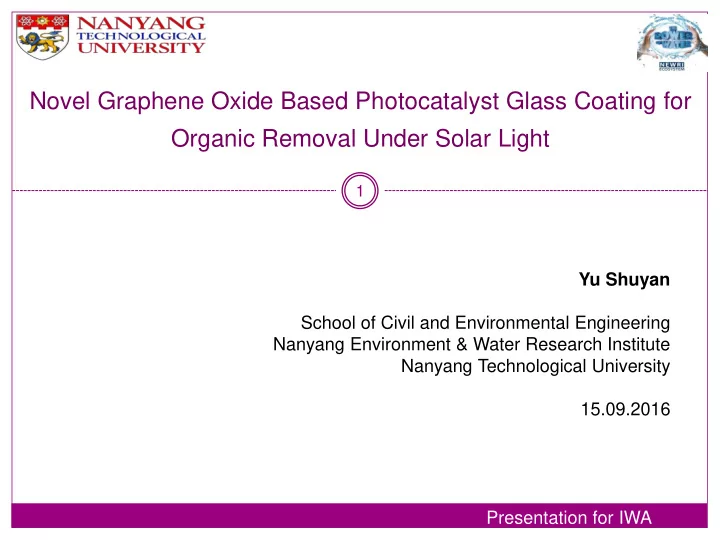

Novel Graphene Oxide Based Photocatalyst Glass Coating for Organic Removal Under Solar Light 1 Yu Shuyan School of Civil and Environmental Engineering Nanyang Environment & Water Research Institute Nanyang Technological University 15.09.2016 Presentation for IWA
Contents 2 Introduction Literature Review Objective Results & Discussion Conclusions Introduction | Literature Review | Objective | Results | Conclusion
Contents 3 Introduction Literature Review Objective Results & Discussion Conclusions Introduction | Literature Review | Objective | Results | Conclusion
Introduction 4 Water pollutants: Inorganic wastewater Emerging organic contaminants (EOCs) Microorganism Conventional water treatment plants : Inadequate Harmful disinfection byproducts (DBPs) Introduction | Literature Review | Objective | Results | Conclusion
Introduction 5 Emerging treatment technology: Semiconductor-mediated heterogeneous photocatalysis Advantages: non-hazardous and economical semiconductors Shorter reaction time Complete mineralisation of the contaminants into harmless substances Introduction | Literature Review | Objective | Results | Conclusion
Contents 6 Introduction Literature Review Objective Results & Discussion Conclusions Introduction | Literature Review | Objective | Results | Conclusion
Semiconductor-mediated heterogeneous photocatalysis 7 Mechanism Light Particles of Oxygen in the Air Photocatalyst Harmful Organic Materials O 2 Electron Superoxide Anions O 2 - e - Reduction CB Decomposition Light VB h + O Oxidation H Water in Hydroxyl Radicals Hole the Air OH - CO 2 and Water Introduction | Literature Review | Objective | Results | Conclusion
Solar Photo-disinfection 8 With the aid of the reactive oxygen species (ROS) , microorganisms such as bacteria and viruses could be effectively destroyed . Introduction | Literature Review | Objective | Results | Conclusion
Contents 9 Introduction Literature Review Objective Results & Discussion Conclusions Introduction | Literature Review | Objective | Results | Conclusion
Carboxylic acid functionalised Graphene Oxide (GO-COOH) Sheets 10 Dye Bacteria Advantages: Nanoparticles molecules Cells Excellent photocatalytic conductivity Large surface area (2600 m 2 /g) GO-COOH vs GO: Further carboxylation: enhanced Carboxyl functional groups hydrophilicity and more carboxyl groups as anchoring sites to Effective support for inorganic nanoparticles to attach on GO-COOH strongly bind contaminants to Sheets the surface of GO-COOH Strong binding ability with the dye molecules via π - π interactions Bacteria cells can be assembled and adsorbed on the GO-COOH sheets Disadvantages : Aggregation as suspensions in solution Introduction | Literature Review | Objective | Results | Conclusion
Copper Sulfide (CuS) as Semiconductor 11 Advantages Limitations • • Nontoxic Low photogenerated charge transfer rate on • Stable under ambient conditions the photocatalyst surface. • • Low cost Tendency for nanoparticles aggregation • • Promote photocatalysis under visible light Disinfection ability not so strong irradiation (narrow band gad 2.1eV) Introduction | Literature Review | Objective | Results | Conclusion
Considerations for CuS-based nanocomposite 12 Glass coating increases the ability in recovery, recycling and isolating these nanoparticles Novel copper sulfide-based nanocomposites (GO-COOH- CuS-Ag) for water remediation: Synergistic effect GO: Suitable support and enhanced photocatalytic ability Ag: Enhanced disinfection ability CuS Introduction | Literature Review | Objective | Results | Conclusion
Contents 13 Introduction Literature Review Objective Results & Discussion Conclusions Introduction | Literature Review | Objective | Results | Conclusion
Morphological and Structural Analysis 14 XRD patterns TEM and FESEM images Introduction | Literature Review | Objective | Results | Conclusion
Optical Properties 15 Enhanced Absorbance Best (a) UV-vis diffuse reflectance spectra (DRS) Introduction | Literature Review | Objective | Results | Conclusion
Photocatalytic Degradation of MB 16 Best (a) Photocatalytic performance for MB (40 ppm) Introduction | Literature Review | Objective | Results | Conclusion
Comparison of Antibacterial capabilities 17 Best Antibacterial activities of GO-COOH-CuS-Ag for E. coli Introduction | Literature Review | Objective | Results | Conclusion
Photocatalytic Mechanism 18 Schematic illustration of proposed electron transfer mechanism of GO-COOH-CuS-Ag nanocomposites . Introduction | Literature Review | Objective | Results | Conclusion
Contents 19 Introduction Literature Review Objective Results & Discussion Conclusions Introduction | Literature Review | Objective | Results | Conclusion
Conclusions 20 • High performance potential in photodegradation and 1 photo-disinfection processes of GO-COOH-CuS-Ag glass coatings 2 • Advantage of simplifying the recovery and reuse in comparison to powdered forms. 3 • Reducing problems including the agglomeration of powdered particles that may cause blockages. Introduction | Literature Review | Objective | Results | Conclusion
Acknowledgements 21 Paper was submitted to the Journal of Hazardous Materials Nanyang Technological University (M4081044) Ministry of Education of Singapore (M4011352) Nanyang Environment & Water Research Institute
Question and Answer 22 Introduction | Literature Review | Objective | Results | Conclusion
Recommend
More recommend